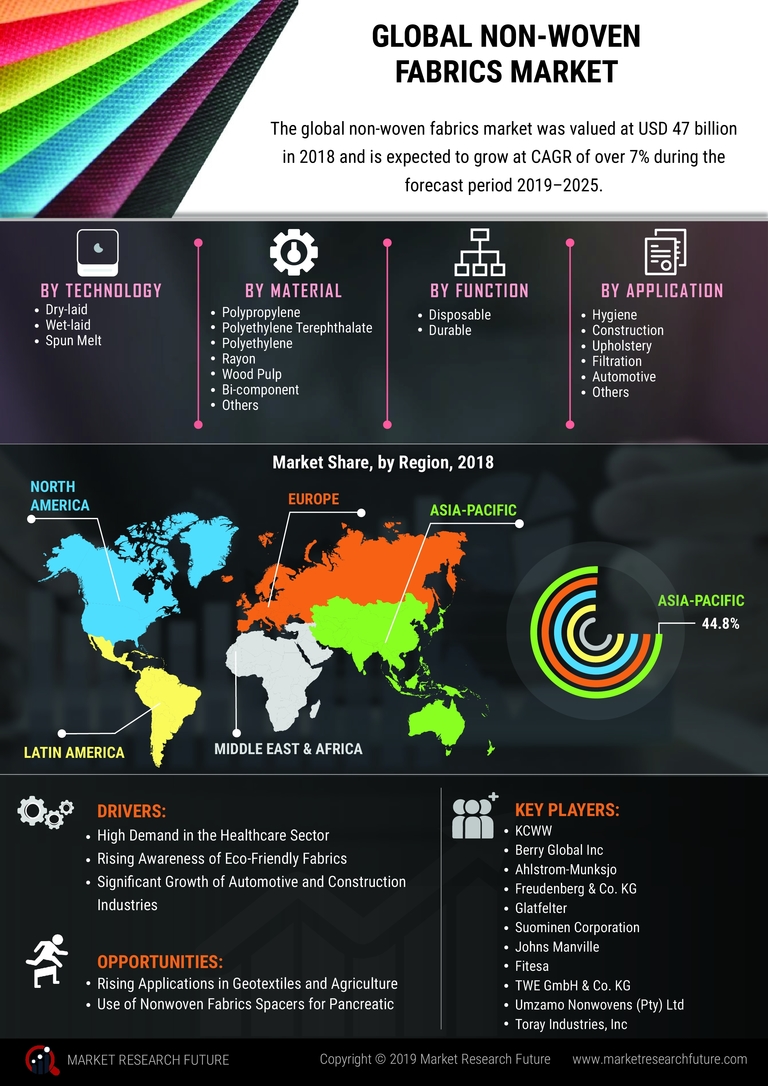Global Nonwoven Fabrics Market Overview
Nonwoven Fabrics Market Size was valued at USD 31.1 billion in 2021. The Nonwoven fabrics industry is projected to grow from USD 33.27 Billion in 2022 to USD 53.43 billion by 2030, exhibiting a compound annual growth rate (CAGR) of 7.0% during the forecast period (2024 - 2030). Increased domestic demand for sanitary goods and rising demand from the healthcare sector are the key market drivers enhancing market growth.
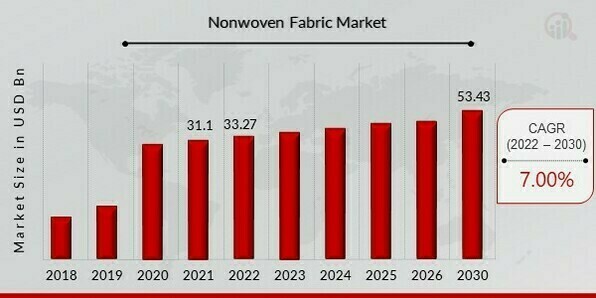
Source: Secondary Research, Primary Research, MRFR Database and Analyst Review
Nonwoven fabrics Market Trends
-
An increase in demand from the healthcare sector to propel market growth
As per market dynamics, nonwoven textiles are being increasingly utilized in medical applications as more reasonably priced products become accessible in hospitals with tight budgets. Surgical gowns, drapes, gloves, and instrument covers—disposable and reusable—are routinely used in hospitals. Government programs to reduce HAIs support using non-woven medical products, such as disposable patient gowns, drapes, and linens (Hospital Acquired Infections). The main factor driving the rise in demand for these goods in the healthcare industry is their ability to help stem the spread of HAIs. Additionally, the aging population in western nations combined with the expanding healthcare sector in emerging regions will further accelerate the growth rate of the Nonwoven fabric market. The increase in birthrate will also contribute to an increase in market value. Additionally, the market's overall expansion is accelerated by rising disposable income and rising spending on healthcare facilities and services.
Figure 1: Nonwoven Fabrics Market Distribution ( 2020-2026)
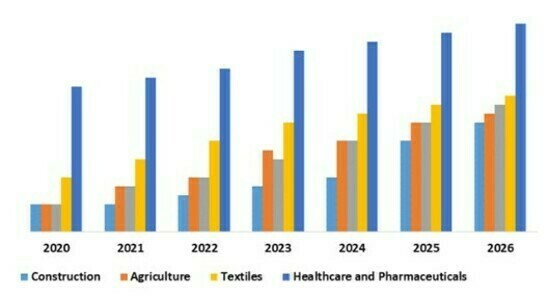
Source: Secondary Research, Primary Research, MRFR Database and Analyst Review
Numerous healthcare goods, including surgical gowns, aprons, drapes, face mask components, and wound dressings, are made from Non woven fabric. They are also used in hygiene items, including tampons, baby diapers, sanitary towels, napkins, and liners. The demand for non-woven face masks has significantly increased as a result of the COVID-19 outbreak in order to stop the virus from spreading. As a result, the demand for Nonwoven materials is rising exponentially ly. Due to the growing usage of female hygiene products in nations like China and India, Asia-Pacific expects to see considerable growth in the use of hygiene products throughout the projected period.
More than 60% of Indian women do not utilize sanitary items. This is mostly because there are so many people living in rural regions. The market for Non woven s in the nation is anticipated to expand quickly due to the rise in sanitary care product adoption rates brought on by increased hygiene concerns. According to Statista, sanitary napkin sales in India hit 10.31 billion units in 2021, increasing by almost 100% over the previous five years. Due to rising hygiene-related concerns, the market for infant diapers and feminine products has also been expanding quickly in China.
According to SDMA, the overall cost of wound care in the United Kingdom is anticipated to be roughly EUR 8.3 billion (USD 9.7 billion). The management of unhealed wounds accounts for around 67%, causing the need for nonwoven fabrics. Every year, the NHS treats 3.8 million patients or around 7% of the world's adult population.
The COVID-19 pandemic has positively impacted the market for Nonwoven textiles worldwide. Production of protective gear, including isolation gowns, head coverings, face masks, curtains, and shoe covers, has been in high demand from the healthcare industry. Despite the covid pandemic seeming to be under control after harming humanity for two years, individuals still want to keep protected and buy these goods to safeguard their families and themselves. In the end, this encourages the usage of Nonwoven goods, contributing to the growth of the worldwide Nonwoven fabrics market. It is anticipated that this trend will also persist from 2021 to 2031.
Nonwoven fabrics Market Segment InsightsNon woven fabric Material Insights
Based on material, the Nonwoven fabric market segmentation includes PP, PE, PET, and Bio-Composites. Due to the increased use of polypropylene Nonwoven fabrics in geotextiles and its attributes such as high tear and puncture resistance, temperature fluctuation tolerance, and durability, the polypropylene (PP) segment had a significant market share for Non woven fabrics in 2021. In addition, a strong demand for sanitary goods for infants, women, and adults from the hygiene sector is anticipated to drive market expansion. Growing consumer awareness of personal hygiene has also led to a surge in demand for diapers, incontinence products, dry & wet wipes, and sanitary napkins, propelling the market.
Figure 2: Nonwoven Fabrics Market by Material, 2021 & 2030 (USD Million)
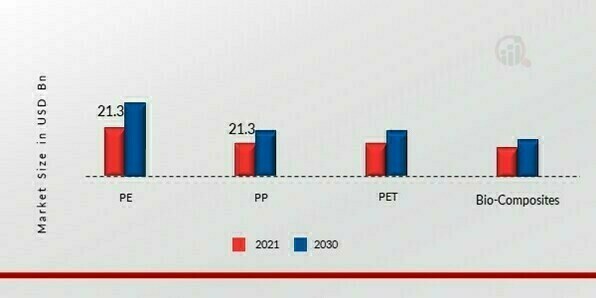
Source: Secondary Research, Primary Research, MRFR Database and Analyst Review
Non woven fabric Technology Insights
Based on technology, the nonwoven fabrics market segmentation includes dry-laid and spunmelt. Due to the rising demand for these spunmelt Non woven s across several applications in hygiene goods, construction, coating substrates, agriculture, battery separators, wipes, and filtration, the spunmelt sector accounted for a significant part of the Non woven fabrics market in 2020. Additionally, one of the most popular methods for producing Nonwoven textiles in greater quantities is spunmelt.
Non woven fabric Function Insights
Based on function, the Nonwoven fabrics market data includes Disposable and non-disposable. In 2021, the disposable sector held a sizable market share for the nonwoven fabrics market. The need for geotextiles in buildings and roads has increased due to rising construction investment in emerging economies like Brazil, China, and India. This increase in demand is anticipated to fuel demand for Non woven s in long-lasting applications.
Nonwoven fabrics Application in Insights
The nonwoven fabrics industry, based on Application, includes Personal Care & Hygiene, Construction, and Automotive. In 2020, personal care and hygiene held a sizable market share for Non woven textiles. Because of their better absorption capabilities, softness, smoothness, strength, comfort & fit, stretchability, and cost-effectiveness, Non woven s are utilized in hygiene products instead of conventional fabrics. The COVID-19 pandemic is spreading, increasing demand for Non woven fabrics for hygiene applications and opening up additional business prospects for Non woven hygiene product makers.
Nonwoven fabrics Regional Insights
By Region, the study provides market insights into North America, Europe, Asia-Pacific and the Rest of the World. Asia pacific nonwoven fabrics market accounted for USD 12.5 billion in 2021 and is expected to exhibit a significant CAGR growth during the study period. Due to the growing domestic demand for hygiene goods, the expanding working population, and a strengthening economy, Asia-Pacific accounted for a significant portion of the market in 2020. Due to the distinctive functional qualities that Non woven fabrics offer, such as hygiene & safety, cost-effectiveness, durability, strength, lightweight, versatility, user-friendliness, environmental-friendliness, and logistical convenience, the demand for Non woven fabrics in the Region is increasing in automotive, agricultural, geotextiles, industrial/military, medical/healthcare, and construction industries.
Further, the major countries studied in the market report are The U.S., Canada, Germany, France, the U.K., Italy, Spain, China, Japan, India, Australia, South Korea, and Brazil.
Figure 3: NONWOVEN FABRICS MARKET SHARE BY REGION 2021 (%)
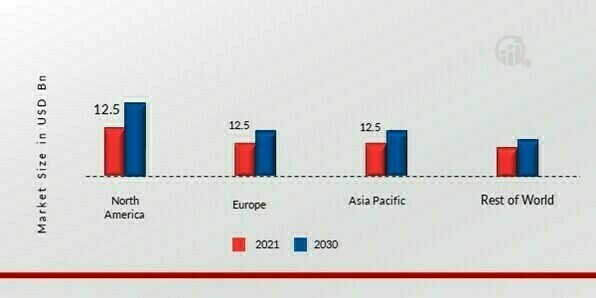
Source: Secondary Research, Primary Research, MRFR Database and Analyst Review
On the other hand, the North American Nonwoven fabrics market is anticipated to expand profitably between 2022 and 2029 due to the rapid development of new technologies in the area. Due to the growth of infrastructure and building activities, North America (the U.S. and Canada) and Latin America are recognized as the second-largest hub for the manufacturing of Nonwoven fabrics. Additionally, the Region's market demand is further boosted by the growing healthcare spending. Further, the Canada Nonwoven fabrics market held the largest market share, and the U.S. Nonwoven fabrics market was the fastest-growing market in the Region.
The European Nonwoven fabrics market is anticipated to expand at a substantial rate. The vehicle is the most popular mode of transportation in Europe, including Germany, the United Kingdom, France, Russia, and Italy. As a result of the significant need for Non woven textiles in the automobile sector, this area has swiftly boosted the Nonwoven fabrics market. Further, the Germany Nonwoven fabrics market held the largest market share, and the U.K. Nonwoven fabrics market was the fastest-growing market in the European Region.
Nonwoven fabrics Key Market Players & Competitive Insights
Major market players are investing a lot of money in R&D to expand their product portfolios, which will spur further market growth for the nonwoven fabrics market. With significant industry changes, including new product releases, contractual agreements, mergers and acquisitions, increased investments, and collaboration with other organizations, market participants are also undertaking various strategic activities to expand their presence. To grow and remain in a market that is becoming more and more competitive, Nonwoven fabrics industry competitors must provide affordable products.
Manufacturing locally to cut operational costs is one of the main business tactics. The Nonwoven fabrics industry serves customers and increases the market sector. The Nonwoven fabrics industry has recently given medicine some of the most important advantages. The Nonwoven fabrics market major player such as Dow, DuPont, KCWW, Berry Inc., Glatfelter, Fitesa, WE GmbH & Co. KG, Ahlstrom-Munksjö, Kimberly-Clark Corporation, Chevron Corporation, Polymer, Group Incorporation, Asahi Kasei Corporation, Fibertex and others are working to expand the market demand by investing in research and development activities.
Fitesa is a pioneer in the Nonwoven fabrics sector and specializes in offering cutting-edge materials for industrial, medical, and hygiene applications. The acquisition of the South American hygiene Non woven s division of Freudenberg (Germany) by Fitesa was finalized in February 2020. Only the hygiene division of Freudenberg Hygiene Brazil Ltda, which employs 100 people, is being sold. The garment, shoe, and leather operations of Freudenberg Performance Materials in Brazil and other South American countries are unaffected by the transaction.
One of the U.S.'s top producers of geosynthetic and erosion control products, Willacoochee Industrial Fabrics, Inc. (WINFAB), said in August 2022 that it had invested in a brand-new, cutting-edge production line for Non woven geotextiles in Nashville, Georgia. By the second quarter of 2023, the production line should be operational.
Key Companies in the Nonwoven fabrics market include
- Dow
- DuPont
- KCWW
- Berry Inc.
- Glatfelter
- Fitesa
- TWE GmbH & Co. KG
- Ahlstrom-Munksjö
- Kimberly-Clark Corporation
- Chevron Corporation
- Polymer Group Incorporation
- Asahi Kasei Corporation
- Fibertex
Nonwoven fabrics Industry Developments
-
June 2020: Suominen created a Non woven material for use in the production of face masks. The novel Non woven has met the pressure drop and filtering efficiency standards of European Standard EN 14683:2019 Type II. This novel substance, which was created in collaboration with VTT, is the newest member of the FIBRELLA family. Production of FIBRELLA Shield has already begun at Suominen's Nakkila facility. Currently, the factory has the capacity to make enough material for 15 million masks per month.
-
May 2020: This month, the Spartanburg, South Carolina, Johns Manville facility began producing Non woven textiles that will be used to create disposable medical gowns. Level 3 medical gowns are produced using the innovative polyester spun-bond Non woven . In comparison to materials used for Level 1 and Level 2 medical gowns, the fabric delivers greater liquid barrier performance while simultaneously delivering comfort and stitch strength.
-
May 2020: By agreeing to four new projects with technology provider Reicofil (Germany), Fitesa is increasing its capacity. The package comprises cutting-edge machinery that will greatly expand capacity to service the healthcare and hygiene markets, producing Non woven s for diapers, sanitary items, surgical and N95 facemasks, and medical gowns and drapes.
Nonwoven fabrics Market Segmentation
Nonwoven fabrics Material Outlook
Nonwoven fabrics Technology Outlook
Nonwoven fabrics Function Outlook
- Disposable
- Non-Disposable
Nonwoven fabrics Application Outlook
- Personal Care & Hygiene
- Construction
- Automotive
Nonwoven fabrics Regional Outlook
- North America
- Europe
- Germany
- France
- UK
- Italy
- Spain
- Rest of Europe
- Asia-Pacific
- China
- Japan
- India
- Australia
- South Korea
- Australia
- Rest of Asia-Pacific
- Rest of the World
- Middle East
- Africa
- Latin America
| Report Attribute/Metric |
Details |
| Market Size 2021 |
USD 31.1 billion |
| Market Size 2022 |
USD 33.27 billion |
| Market Size 2030 |
USD 53.43 billion |
| Compound Annual Growth Rate (CAGR) |
7.0% (2024-2030) |
| Base Year |
2021 |
| Market Forecast Period |
2024-2030 |
| Historical Data |
2018 & 2020 |
| Market Forecast Units |
Value (USD Billion) |
| Report Coverage |
Revenue Forecast, Market Competitive Landscape, Growth Factors, and Trends |
| Segments Covered |
Product Type, Operating Platforms, and Region |
| Geographies Covered |
North America, Europe, Asia Pacific, and the Rest of the World |
| Countries Covered |
The U.S, Canada, Germany, France, the U.K., Italy, Spain, China, Japan, India, Australia, South Korea, and Brazil |
| Key Companies Profiled |
Dow, DuPont, KCWW, Berry Inc., Glatfelter, Fitesa, WE GmbH & Co. KG, Ahlstrom-Munksjö, Kimberly-Clark Corporation, Chevron Corporation, Polymer, Group Incorporation, Asahi Kasei Corporation, Fibertex. |
| Key Market Opportunities |
Attracting automobile producers utilized in the production of car mats, covering materials used in cars, seat covers, window frames, sun shields, and various filters |
| Key Market Dynamics |
Demand for surgical drapes and gowns |
Non woven Fabric Market Highlights:
Frequently Asked Questions (FAQ) :
The Non woven fabric market size was valued at USD 31.1 Billion in 2021.
The Non woven fabric market is projected to grow at a CAGR of 7.00% during the forecast period, 2024-2030.
Asia Pacific had the largest share of the Non woven fabric market
The key players in the Non woven fabric market are Dow, DuPont, KCWW, Berry Inc., Glatfelter, Fitesa, WE GmbH & Co. KG, Ahlstrom-Munksjö, Kimberly-Clark Corporation, Chevron Corporation, Polymer, Group Incorporation, Asahi Kasei Corporation, Fibertex.
The PP Non woven fabric category dominated the market in 2021.
Personal care & hygiene had the largest share in the Non woven fabric market.









